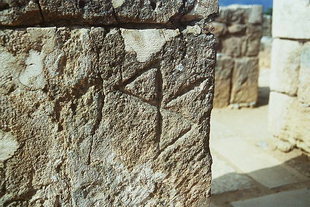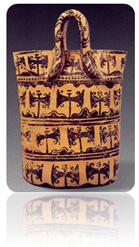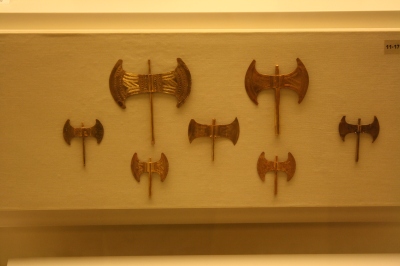 “There’s a river of birds in migration, a nation of women with wings.” —Goddess chant, Libana
“There’s a river of birds in migration, a nation of women with wings.” —Goddess chant, Libana
On the Goddess Pilgrimage to Crete, I explain that many of the names given to “Minoan” (c. 3000-1450 BCE) Cretan artifacts and architecture are products of patriarchal and Eurocentric imaginations, and as such, are misleading. For example the name “Minoan” was given to the culture of Bronze Age Crete in honor of “King Minos,” who was said to have ruled in Crete a few generations before the Trojan War–several hundred years after the end of the culture to which his name was attached. In fact, despite his eagerness to find evidence that King Minos ruled at Knossos, the excavator Sir Arthur Evans finally had to concede that the best he could do was to produce a fresco of a “Prince of the Lilies” which he identifed as the image of the male ruler of the culture he called “Minoan.” Evans’ Prince had white skin, a fact that Evans conveniently overlooked–because according to his own interpretation of “Minoan” iconography, white skin would mark the figure as female. Mark Cameron, who reviewed Evans’ reconstruction of the fresco, suggested that the Prince is more likely to be a young woman who is perhaps leading a bull to take part in the bull-leaping games. He also stated that the “crown” belonged to another fresco altogether.
Evans’ failure to find evidence of a King or for that matter a Queen at the complex of buildings he called “The Palace of Knossos” calls into question his idea that these structures were palaces. Nanno Marinatos argued that the “palace” was instead a ritual center for the surrounding village, as well as a community gathering place, a place for storing grain, wine, and oil in a sacred way, and a place where ritual objects were fashioned of clay, bronze, stone, and gold. Following her lead, I renamed the “Palaces” “Sacred Centers.” In this blog I will experiment with renaming the “Minoan” culture “Ariadnian,” after the pre-Greek name Ariadne, which may be one of the names of the Goddess of Bronze Age Crete.
One of the most pervasive–and many would say–most enigmatic symbols of the Ariadnian culture is the labrys.  Labrys is a pre-Greek word which is usually translated as “double axe.” Labrys is the root of the word labyrinth, the home of the labrys. In Ariadnian Crete, the labrys is sometimes a pair of triangles joined at their apexes. This symbol is also found in Anatolia in the Neolithic era, for example, at Catal Huyuk. This image suggests the doubling of the sacred, life-giving, female public triangle. The labrys is carved on stones used in buildings in this way. However, in Crete the labrys is more frequently painted or cast in bronze or gold in a rounded shape that is only vaguely reminiscent of doubled triangles. The labrys comes to symbolize more than the female triangle doubled.
Labrys is a pre-Greek word which is usually translated as “double axe.” Labrys is the root of the word labyrinth, the home of the labrys. In Ariadnian Crete, the labrys is sometimes a pair of triangles joined at their apexes. This symbol is also found in Anatolia in the Neolithic era, for example, at Catal Huyuk. This image suggests the doubling of the sacred, life-giving, female public triangle. The labrys is carved on stones used in buildings in this way. However, in Crete the labrys is more frequently painted or cast in bronze or gold in a rounded shape that is only vaguely reminiscent of doubled triangles. The labrys comes to symbolize more than the female triangle doubled.
Though books still say that the “double axe” was used to sacrifice the bull, there is in fact no evidence for that. Nor is the labrys ever pictured as a “battle axe,” a weapon of war. The labrys is never shown in Ariadnian Crete in the hands of a man or a boy–but only in the hands of women or Goddesses.
 Large bronze labryses attached to wooden poles mark sacred spaces and are analogous to crosses that signify Christian sacred spaces. Small gold labryses were found wedged into stalagmites in the ritual cave of Mt. Dicte. On pottery the labrys “pole” sometimes becomes the head and body of what seemed to Marija Gimbutas to be a butterfly, and to others a nacent “angel.”
Large bronze labryses attached to wooden poles mark sacred spaces and are analogous to crosses that signify Christian sacred spaces. Small gold labryses were found wedged into stalagmites in the ritual cave of Mt. Dicte. On pottery the labrys “pole” sometimes becomes the head and body of what seemed to Marija Gimbutas to be a butterfly, and to others a nacent “angel.”
In many visits to the museums and archaeological sites of Crete, I have considered many interpretations, but none unlocked the “mystery” of the labrys for me. As labrys is a difficult and unfamiliar word for many, I have often referred to the labrys as a “double axe.”
While thinking about a recent pilgrimage, I recalled that I was corrected by one of the other pilgrims when I used the archaeologist’s term “lustral bath” to refer to a small ritual room–after I had already explained that this and similar places could not be “baths” because they lacked drains. For some reason my mind jumped to the mystery of the labrys. I wondered if my frequent reference to it as a “double axe” also needed to be corrected.
 After an internet search that brought up several images of the labrys, words formed in my mind: “If you are not a double axe, then what are you?” The answer came immediately: “We are wings.” “Of course.” I responded, “you are wings.” Why did it take me so long to recognize that?
After an internet search that brought up several images of the labrys, words formed in my mind: “If you are not a double axe, then what are you?” The answer came immediately: “We are wings.” “Of course.” I responded, “you are wings.” Why did it take me so long to recognize that?
According to Marija Gimbutas, the bird is one of the most common images of the Goddess of Old Europe–and Ariadnian Crete was the last flowering of Old Europe. Birds are universally admired for their powers of flight. Their appearance during a ritual in Ariadnian Crete was understood as the hierophany of the Goddess–think of the Holy Spirit descending as a dove. The days marked by the return of birds in spring and their departure at the end of the summer were correlated with planting and harvesting. A bird egg is a symbol of fertility, a bird nest is a symbol of home, and the care and concern of birds for their young is a model for parenting. To paraphrase Black Elk, because it means all this and so much more, the bird is sacred.
I suspect that my repetition of the words double axe had closed my mind to “seeing” the labrys as wings. But as soon as the labryses spoke to me, a cloud of mystification lifted from my mind. Since then, I have felt an unexpected lightness of being. I find myself singing, “There’s a river of birds in migration, a nation of women with wings,” while I go about my days. Extending my arms to “fly,” I realize that the rounded shape of the labrys is the shape a human being makes when her arms imitate wings. This too is intuitively satisfying.
I don’t know about you, but I will never see the labrys as a “double axe” again. From now on I will repeat the message I received, “we are wings”: double wings, wings of flight, wings of migration, wings of mothering and fathering birds bringing food to their young, wings of the Goddess inspiring, embracing, and protecting all life. Blessed be!
Carol P. Christ has just returned from a life-transforming Goddess Pilgrimage to Crete which she led through Ariadne Institute. The culture of ancient Crete, the last flowering of Old Europe, is one of the wellsprings of her spiritual vision, and there she participates in rituals that invoke Goddess and celebrate the connection of all beings in the web of life. It is not too late to join the fall pilgrimage, nor too early to sign up for spring 2014. Carol spoke on a WATER Teleconference recently. Her books include She Who Changes and Rebirth of the Goddess and the widely-used anthologies Womanspirit Rising and Weaving the Visions.


I love this Carol, indeed I am with you ..they are wings! I had a dream only 2 nights ago that I was in a tattoo parlour having the Labrys tattooed on my back. It was such a vivid dream. Maybe this dream could be interpreted as me needing to find my wings again. I only just asked my little girl Avalon 5 minutes ago if she had put her wings on today because I couldn’t see them, she told me they were under her jumper :)
LikeLike
Wonderful, Carol! Your discoveries on Crete, both external and internal, make so much sense. I think we goddesses have eyes to delve into symbols’ deeper, original meaning of the pre-agriculturalist communities, when people foraged, shared and worshipped together for the highest good. An era when our female energies, fertility and abundance were revered.
I look at the labrys and see the gaps where today’s women’s wings will be completing the symbol, to create the eternal labryinth of the soul, world, and the need to heal the destructive, ego-mind, which keeps so many of us enslaved. The 3rd millennium is a great gift to the emerging female mystery. Thank you for this!
LikeLike
I take a small rune daily as a spiritual guide. And one of the runic symbols is identical to your wings . In Runic lore, it means a butterfly and is the symbol for transformation, as the larva transforms into a butterfly, the lower nature transforms into the divine. I would think anywhere those symbols are found was a place of healing and sacred ritual to do the same.
LikeLike
A splendid post, Carol, thank you so much!! Your question on the labrys evokes a fascinating and powerful symbol. Your vision of the bird is your immortal spirit or soul I think manifesting in your contemplation, as if in a dream.
Gorgeous sacred labrys here at Wiki, so profoundly moving

LikeLike
How many other symbols have we failed to understand? This is thrilling!
LikeLike
Carol, thank you so much for opening our eyes–and our wings!
LikeLike
Carol, thank you for plunging into the deep reservoirs of your inner mind and pulling out this wonderful answer. Of course, the labrys is a symbol for wings! I think your revelation conjoins with so many inklings and oracles — including my own — that we are entering a period when the Goddess is being reborn (to paraphrase the UCC, “The Goddess is still speaking”). Your post lifts me on the wings of the Goddess!
LikeLike
Carol, this is beautiful! Surely you’ve read “When Women Were Birds”, and you’ve heard of the many tales from Native American women about the women/bird connection. It feels like this is more than a Greek legend or symbol. It feels universal. And it feels right.
LikeLike
Thanks, passing this on to the Mary Daly Team. There is a labrys on her dark green marble gravestone at Mt. Auburn Cemetery in Cambridge, MA. Best wishes, Carol, MEH
LikeLike
I did wonder what she and other lesbians who adopted the image of the labrys as a symbol of female power would think of this interpretation. I am hoping they would love it as much as I have.
LikeLike
Reblogged this on Adventures and Musings of a Hedgewitch.
LikeLike
“The labrys is never shown in Ariadnian Crete in the hands of a man or a boy–but only in the hands of women or Goddesses.”
This little quote made my day Carol. I loved this article, and it just goes to show, that women’s ancient images can be invisible to the male eye.
LikeLike
Beautiful result of deep thinking, Carol! Perhaps then labyrinth, “home of the labrys,” signifies a nest?
LikeLike
I love it! Thanks, Martha!
LikeLike
Martha, some might say it represents the workings of a woman’s mind – lol. (truly, just kidding, although we do imagine complex images)
LikeLike
I’ve always loved Libana’s rendition of this song, and the symbolism of the labrys as wings is just perfect! Thanks, Carol!
LikeLike
Thanks for the reference, I didn’t find it when I was posting this.
LikeLike
Believe it or not, I actually have a double ax, very large in the trunk of my car. A friend gave it to me years ago–made of plastic. Every now and then, when I meet a young lesbian, I’ll show her the labrys— never know when you might need one!
So King Minos was not around during the beginning of the Minoan period? That was fascinating, and also the fact that the palaces may not have been palaces. I kind of like the phrase spiritual centers. The myths and legends of Minoan civilization were very inspiring to our little group of lesbian feminists decades ago, and it all still makes me smile. I’ve always loved the idea of women’s peaceful civilizations, and really, if half the world would let go patriarchy and all its trappings, women could indeed change the world. We have to figure out how it is that we continue to aid and abet male supremacy, and what is it that holds women in bondage no matter what we do.
Liberalism will not get us there!
LikeLike
Beautiful! I always thought of the labrys as butterflies but I like birds even better. Great and life affirming symbolism! As always, thanks for your deep thoughts.
LikeLike
Thank you for sharing such a beautiful interpretation. I love how easily it came to you once you asked the question: “if you are not a double axe, what are you?”
I also love your name for this wonderful culture: “Ariadnians”.
I’ve contemplated on the labrys for 15 years now and have come up with a few other ideas as well. Perhaps the symbol was a reminder of the double edged nature of technology. In their time, bronze was the technology of the day, and most warrior cultures were using it to make stronger and more deadly weapons with which they could carry out their conquests. The Ariadnians, however, chose to use the metal to make ritual objects and more durable tools, in order to further the common goals of the entire community. Did they understand that technology in and of itself was neither good nor bad, but rather could be used to create or destroy? By making the labrys a central part of their rituals, it’s possible they were reaffirming their conscious choice to use the new technology for altruistic purposes.
The symmetry of the labrys also suggests the idea of yin-yang, the balance between the masculine and feminine energies, which together, make up the whole within each of us.
LikeLike
Old Amazon weapon. Crafted properly it could be thrown end over end with an over hand throw or thrown sideways and fly like a helicopter blade. It has to be crafted to be a balanced weapon — like a throwing knife would be. The handle and the blade have to be of equal weight to where you can balance it sideways on a pole or stick. Many lesbians remember it. A friend of mine, who was a metal worker/blacksmith, made one for his daughter when she came out as a lesbian. It was a working weapon and a beautiful piece of armory.
LikeLike
Live Oak, all archaeologists agree that in ancient Crete the labrys is not ever portrayed as a weapon, not in the hands of a warrior male or female, and not used for animal or human sacrifice. The examples that have been found range from very small to very large and none of them were designed for cutting or killing. There are double hand axes but they are not found in sacred contexts and are shaped differently. In Crete the labyris was a symbol. The question is what exactly it symbolized, and probably it had more than one meaning. I believe ancient Crete was an egalitarian matriarchy or an egalitarian society that celebrated female power and all of nature.
LikeLike
I am so with you about not using “Minoan”!!!
LikeLike